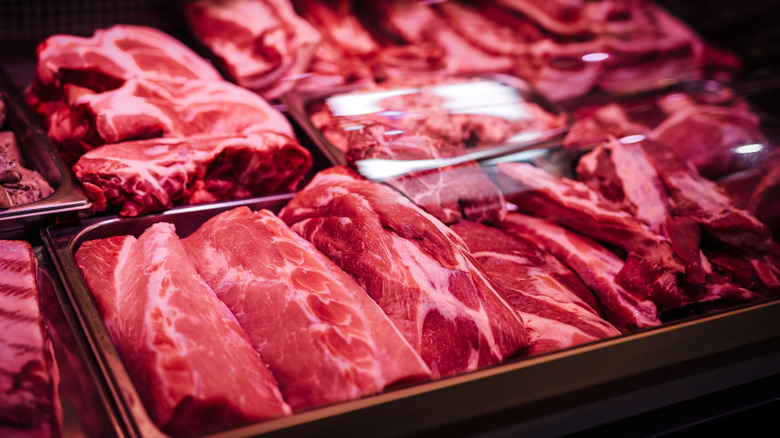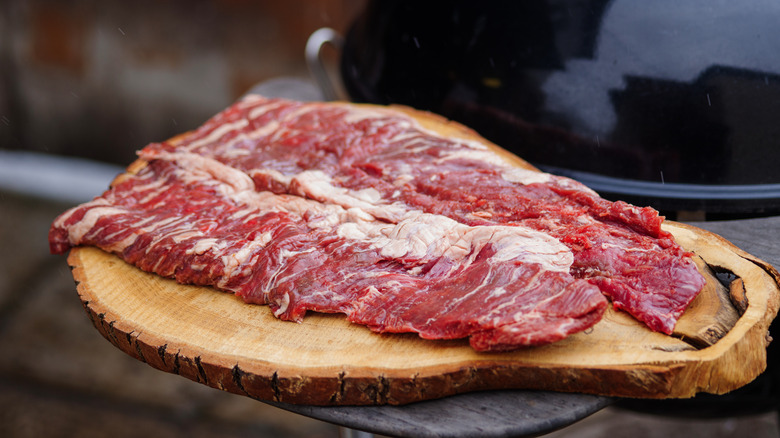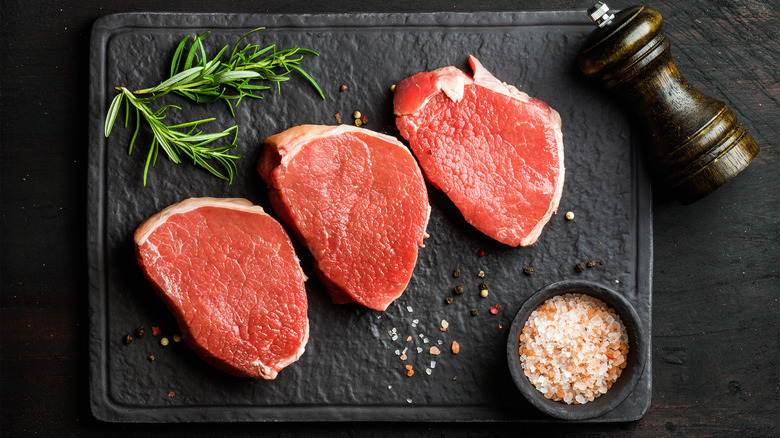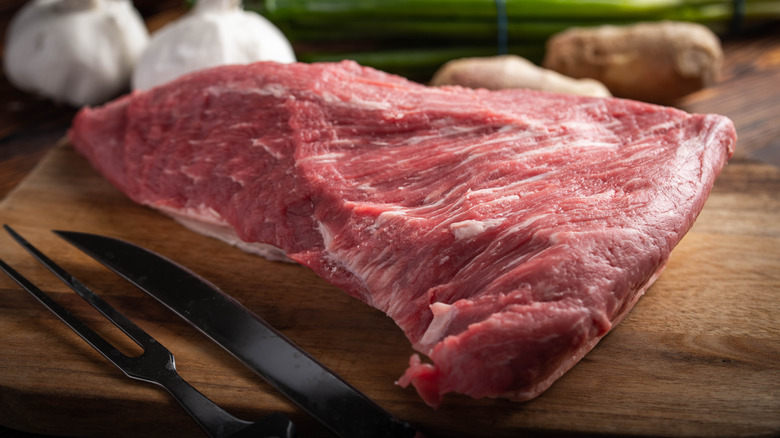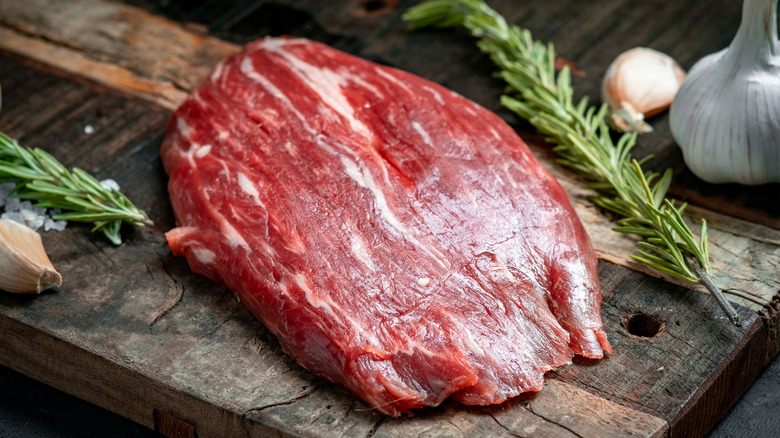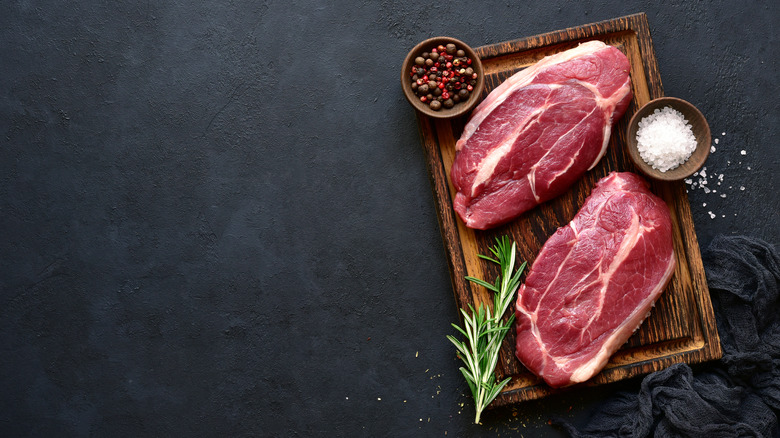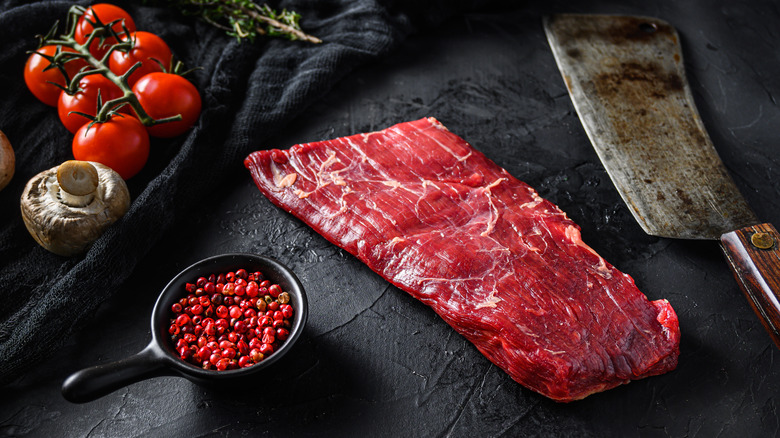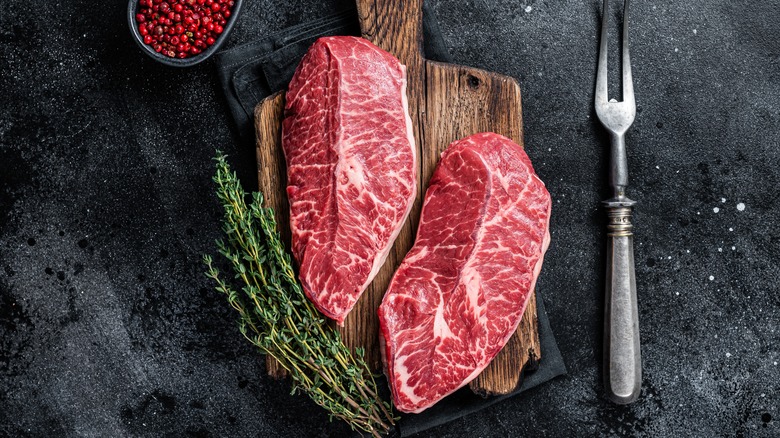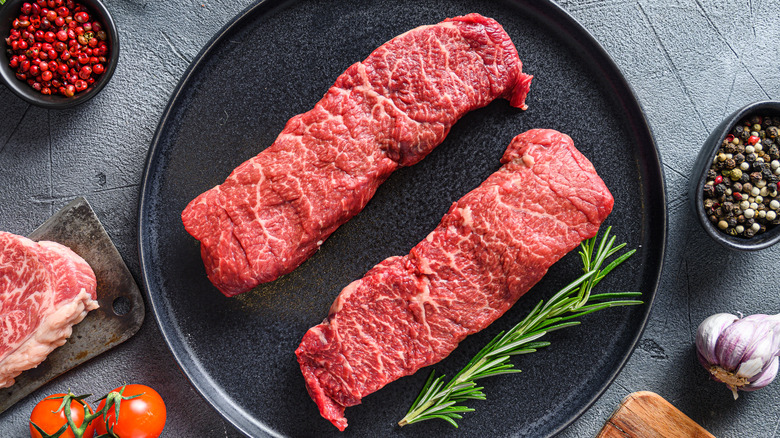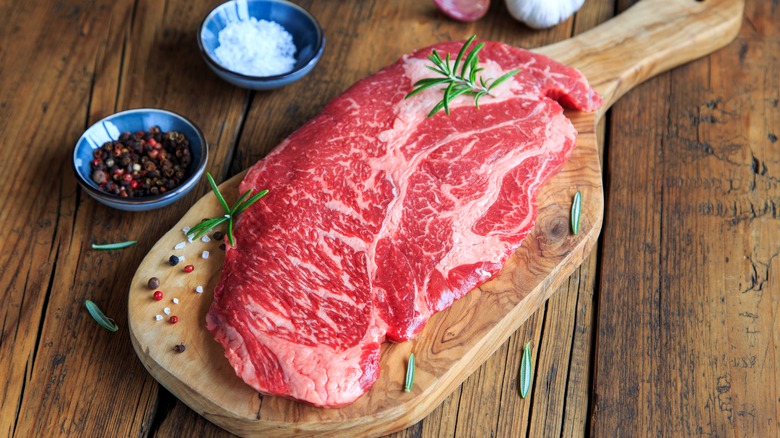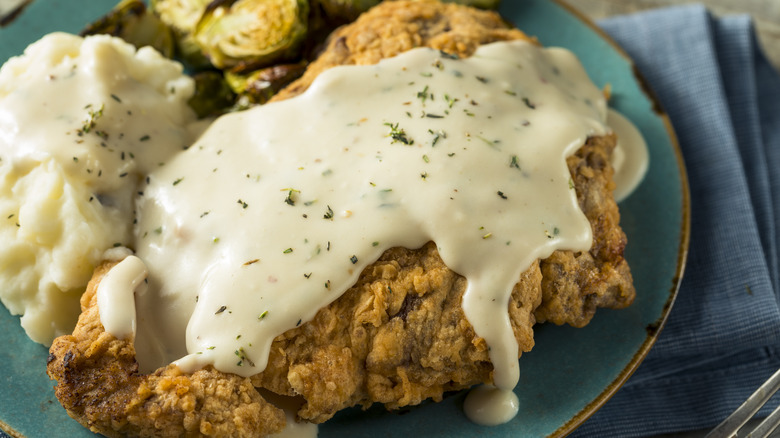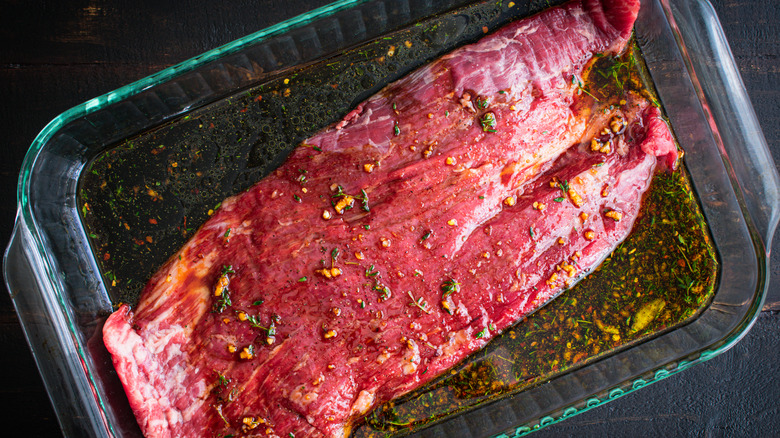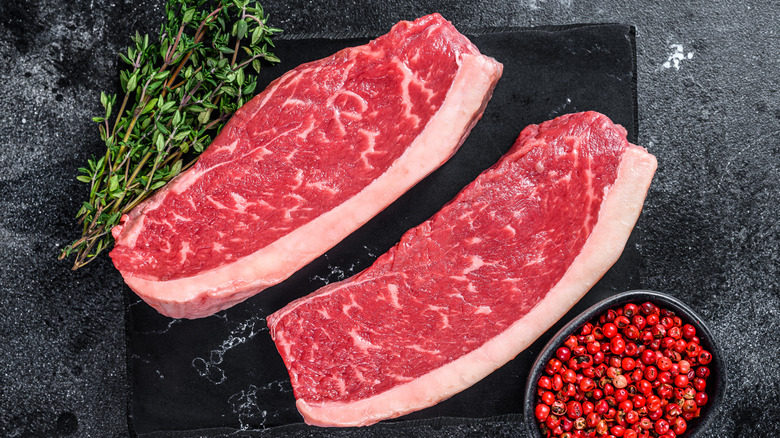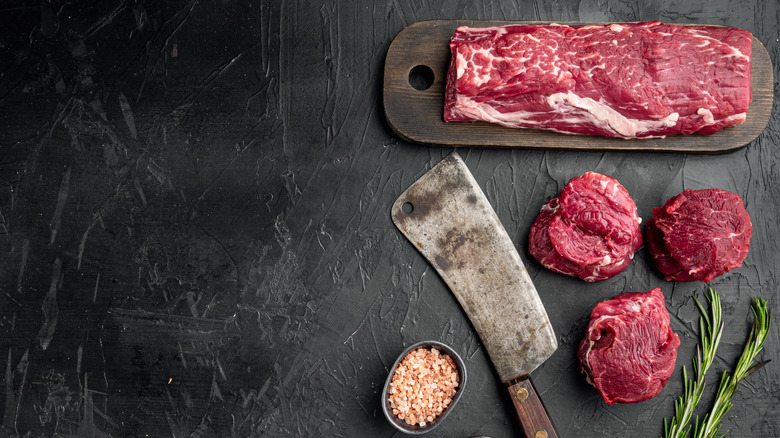13 More Affordable Cuts Of Steak
Digging into a beautifully cooked steak surrounded by loved ones is one of life's most fundamental and endearing pleasures. There are a wide variety of side dishes and beverages to help enhance the beef you've picked out and tended to with care, all of which can be shared with the company to create an eating experience greater than the sum of its parts.
However, not everyone can afford to drop $80 on a dry-aged porterhouse or specialty order a filet from the local butcher. Luckily, enjoying a good steak is just as accessible as any other cut of meat, as long as you know what to look for and the best way to prepare it. Everyone deserves to enjoy a great steak every now and again. Here is a list containing the very best bargain cuts, the biggest bangs for your buck, and some alternatives to the cuts you don't feel like breaking your bank account for.
Flap steak
It's only fitting to kick off the list with this cut of steak. Flap, or bavette, steak has earned the nickname of the butcher's secret because it is lesser known, less ordered, and often saved by a butcher for themselves. Flap steak is cut from the abdomen of the steer, which is where the name "bavette" comes from, the French word for "bib." This is the same region where flank and skirt steak are cut from, but flap cuts have a better muscle-to-fat ratio and are therefore juicier and more flavorful than similar alternatives.
Unlike some lower-cost cuts of steak, flap steak has a medium to high-fat content so that it can be cooked the same as more expensive, fattier cuts. Its robust beefy flavor allows it to stand up to seasonings, and it's great for slicing into pieces and tossing in a steak salad or filling tortillas.
Although flap steak is not commonly found in the supermarket, your local butcher should have it available. Flap steak is a cost-efficient bargain cut that gives you a deliciously flavorful main dish. Whatever you've been using skirt steak for, save some money and give this cut a try. You'll be glad you did, and your wallet will be too.
Eye of round
The eye of round cut is one of the leanest cuts of steak out there. What determines a cut's leanness or fattiness is how much exercise the muscle gets. For example, a cut like a ribeye has a high-fat content because it is cut directly off the ribcage of the cow, which is deeper inside the body and not commonly used. The eye of round, on the other hand, is cut from the rump of the cow, one of the most commonly exercised regions. Therefore, it has little to no fat on it. That does not mean it can't be flavorful, however. What this cut lacks in beefiness can be made up for with marinades and the right cooking technique. Plus, a leaner cut means a less expensive and healthier piece of beef.
Lower fat content translates to a lower temperature and slow cooking time. Eye of round is perfect for the pressure cooker or braising in the oven for hours on end. This cut makes a great stew and is also a great option for slicing thin and fixing up a steak sandwich. Plus, the eye of round is one of the least expensive cuts of steak on the market and is readily available at both butcher shops and supermarkets. Although this cut is not as fancy or luxurious as higher-priced cuts, its potential for tastiness is nothing to ignore.
Tri-Tip
The tri-tip is cut from the trip-tip roast, which is found on either side of the leaner portion of the bottom sirloin. Because there are two tri-tips per cow, it is typically a less expensive option than other larger cuts similar in size. The bottom sirloin is generally a more muscley region of the steer, but the end from which the tri-tip is cut typically contains some fat. This fat content is not high, so cooking tri-tip properly is important in getting a tasty result.
Usually, leaner cuts do not stand up to high heat very well, but tri-tip is actually perfect for the grill. The lack of flavorful fat on the cut can be made up for with smokiness, and the intense, confined heat of a grill will make for a crusty exterior. It is recommended not to cook tri-tip past a medium interior, but once it is cooked through, this bigger cut of steak can be sliced for optimal portion control. Like bavette, tri-tip is great in any dish that requires sliced steak and is excellent when marinated.
Flank
Flank steak is often compared to skirt steak. The two cuts share some similarities, but flank steak remains a cheaper option. Both skirt and flank steak are cut from the cow's abdomen. Skirt steak is cut from the portion of the cow known as the plate primal, which is just below the ribs.
Flank steak is cut just behind the skirt, ranging from the ribs to the hip. This area of the cow gets a lot of exercise, so the fat content is typically on the lower side. However, flank steak can be made delicious by cooking it at very high heat, browning the outside, and keeping the inside a juicy medium rare. Flank steak is ideal for beef kebabs, as the toughness of the cut can be avoided by making the steak bite size. Plus, the toughness of flank steak can be remedied by tenderizing the cut ahead of time and marinating extensively.
The most important method required for flank steak, however, is how you cut it. You will find that flank steak has thick muscle fibers running parallel from end to end. If you cut along these fibers, the meat will become stringy and chewy. Instead, cut across the grain of the muscle to keep the meat intact and enhance its tenderness. As a bonus, flank steak is readily available and a bargain cut that will always satisfy your red meat craving.
Sirloin tip
As previously stated, the sirloin is divided into top and bottom portions. The top sirloin is a more fatty, flavorful cut and thus more expensive. The bottom sirloin, which contains the tri-tip, also includes the sirloin tip. This is cut from the outer edge of the sirloin against the round. The sirloin tip is the most tender of the round cuts, but it must be cooked properly to protect its tenderness.
The best way to cook a sirloin tip is to roast it in the oven. This cut is very thick in width, a shape that does not cater to high heat on the stovetop or grill. Instead, roasting your sirloin tip at a lower temperature for a long period of time until it comes up to a more precise temperature will yield the best results.
A roast is normally associated with cuts like a whole tenderloin or a standing rib roast (prime rib), but those cuts are not very budget friendly and are usually options for a special occasion. On the other hand, the sirloin tip is a more affordable roast cut. When cooked properly, it's a comforting roast fit for any hearty Sunday dinner.
Flat iron
The flat iron is cut from the shoulder of the cow. This region, known as the chuck, has a higher amount of fat and is, therefore, more tender and flavorful, but that does correlate to a higher price tag. Cuts from the chuck, while more tender, remain a cheaper alternative to other well-marbled steaks. Flat iron steaks are available in a rectangular shape and are now more commonly available at supermarkets. If your local grocer does not have flat iron steak, a good quality butcher shop will have it in stock.
Flat irons are an excellent vehicle for marinades and, due to the evenly marbled fat, can be cooked to virtually any liking without sacrificing tenderness or taste. High heat will not dry out the meat as quickly, so you can cook your flat iron steak to whatever doneness you prefer or divide the cut and cook each portion to a different temperature. If you normally reach for flank on steak night, give flat iron a try. Chances are, you won't look back.
Blade
Blade steak, or top blade steak, is butchered from the beef chuck into cross-sections with a line of gristle. This line of gristle running through the middle of top blade steaks is what normally turns people away, but the meat surrounding the tough cartilage is anything but chewy. Like many cuts in the chuck, the meat on a top blade cut is well-marbled and buttery in flavor, so the obstacle of eating around the gristle should actually be looked at as a positive since it correlates to a lesser price point.
However, the gristle running through a top blade cut should be considered when cooking the steak. Unlike flat iron, achieving the right interior doneness is a more temperamental task. Top blade steaks should be cooked no further than medium to keep the juicy meat surrounding the gristle from toughening up. When buying steak on a budget, it's important to get the best out of it; the top blade is no exception. You've saved some extra money going with this cut, and it will be delicious as long as it's cooked properly.
Denver
Denver steak has a fascinating background since it was only discovered as an existing cut of steak just over a decade ago. In 2009, the Cattlemen's Beef Board issued the task of finding another cut of steak from the chuck roll. The common chuck steaks from that region at the time were top blade and flat iron, but this new cut was discovered as an even more flavorful option below the blade altogether.
This area, deeper inside the cow's shoulder, is exercised even less than the blade, resulting in more fat marbling despite having no fat cap. The Denver steak is a hidden gem that is now a delicious, inexpensive alternative. They are harder to find, however, most likely only available at an experienced butcher shop. Of the cuts on this list, Denver steaks will cost a few more dollars than their counterparts, but the extra money will be worth the uniqueness and flavor.
Chuck eye
The ribeye steak is the undisputed king of the steakhouse. It's beautifully marbled, deliciously succulent, and a good cut costs a lot, a heck of a lot. Luckily, the chuck eye is available to give you everything you love about the ribeye at a fraction of the cost. This unsung steak hero is cut directly adjacent to the ribeye on the other side of the rib at the beginning of the chuck primal. Basically, the chuck eye is a continuation of the ribeye. Where ribeyes are cut from the sixth to the twelfth rib, the chuck eye is cut from the fifth.
As with many highly-marbled steaks, the chuck eye is cut from the deepest part of the shoulder. All the fat found on the rib cage that gives the ribeye its status and gravitas is also found on the chuck eye. That grandeur is translated into a pricier purchase, but the chuck eye is just as juicy and versatile without breaking your budget. The best way to get your hands on a good chuck eye is to order it from your butcher ahead of time since the cut is in short supply—only two to four cuts are available per cow.
Cube
Cube steaks are versatile, inexpensive, and, when cooked the right way, very delicious. The name derives from the marks left behind after the steak is run through a mechanical tenderizer. These cuts can come from either the top or bottom round portion of the steer, which means they have very little fat on them and are not naturally tender.
One of the best way to utilize cube steaks is by cooking them slowly over a long period of time. This will allow the muscle fibers to relax and separate more easily as opposed to tightening up, which would happen if cooked fast over high heat. Cube steaks are a great option for making a slow-cooked dish like a beef stew. Not only do they not cost much money, but they can also easily be cut into smaller pieces to whatever size you need.
But cube steak is perhaps most notable as the cut of choice for chicken-fried steak. To make this classic dish, which is a particular favorite in Texas, a whole cube steak is dredged and deep fried in oil. Although this cooking method, which is familiar to anyone who has prepared fried chicken, is not low and slow, it is a very forgiving recipe because of the common, copious addition of gravy.
Merlot
Merlot steak is another cut that comes from the round portion of the cow. Like the eye of round, this is very lean with little to no fat on it. The cut is actually a portion of the steer's heel muscle, according to Huff Post. Despite the lack of fat, it remains very tender, when cooked properly.
Merlot cuts can best be compared to flank steak, as they have a similar size, shape, and texture. However, merlot steak has a finer grain than flank, which is what makes it a more tender cut. Thicker muscle fibers correlate to chewier steak, so the finer the muscle fibers are, the better. Because merlot steaks are flat and mostly thin, they are great cuts for the grill — we recommend dividing them into even portions and marinating your steaks ahead of cooking.
Merlots are most likely not going to be found in the meat section of your grocery store, so calling your local butcher would be your best opportunity to get your hands on one.
Picanha
While picanha is slowly emerging as a cult favorite cut in the United States, it remains massively popular in Brazil and will be the steak of choice in any Brazilian steakhouse. Picanha comes from the sirloin cap, which means it has a beautiful piece of fat that runs along an entire side of the steak. This well-marbled cut is best cooked with a quick, hard sear and is the perfect steak for the grill. Throw down a slab or cut the steak into bite-size pieces along the fat cap, place the cubes on skewers, and grill up some kebabs.
If you're unable to track down picanha to cook at home, there are a number of Brazilian steakhouses across the U.S. that feature the steak as the main attraction. Plus, when dining out at these temples of meat (which are often all you can eat), there's a good chance that you'll be treated to the pageantry of having you're picanha sliced to order from large sword-like skewers.
Teres major
If you love filet mignon, this alternative, known as teres major, will allow you to indulge in beefy bliss more often than just special occasions. Another steak cut from the chuck, the teres major, like bavette steak, is also referred to as a butcher's cut because it takes an expert butcher to cut it properly. Once you get your hands on one, however, it can be prepared and enjoyed just like filet mignon. Roasting in the oven is great for serving larger groups of people, although portioning into individual filets and searing in a pan is also an option.
Teres major comes from the muscle connecting the cow's shoulder blade to the front of the shoulder. There is an excess of fat in this area, and a well-experienced butcher can get the right balance between muscle and fat when cutting the teres major. In reality, it can be argued that teres major's well-ratioed fat content puts it a step above filet mignon in flavor since the tenderloin cut has none. Plus, teres major is typically half the cost. Call your local butcher and find out if they can have teres major available. It could be the cut of steak that makes the holidays or special occasions more financially manageable without sacrificing the celebration.
